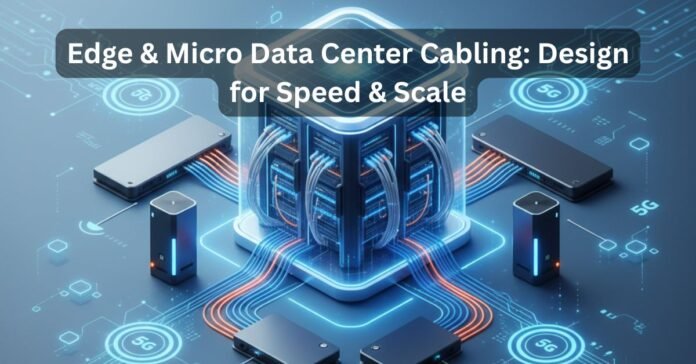As digital transformation accelerates, enterprises are no longer relying solely on large, centralized data centers. The rise of edge computing and micro data centers is reshaping how data is processed, stored, and transmitted. With IoT devices, 5G networks, artificial intelligence (AI), and latency-sensitive applications driving exponential data growth, the need for low latency infrastructure has never been greater.
Unlike traditional facilities, edge and micro data centers are closer to end users, enabling real-time data processing for industries like healthcare, telecommunications, finance, and smart cities. But their efficiency depends on one critical factor: structured cabling. From fiber optic networks to Distributed Antenna Systems (DAS), the backbone of these facilities lies in robust, scalable, and reliable cabling infrastructure. In this blog, we’ll explore how to design edge data center cabling and micro data center connectivity that ensures speed, scalability, compliance, and reliability—future-proofing IT infrastructure for the next wave of innovation.
The Shift Toward Edge & Micro Data Centers
What Are Edge and Micro Data Centers?
- Edge Data Centers: Smaller, localized facilities designed to process data near the source, reducing reliance on distant hyperscale centers.
- Micro Data Centers: Modular, containerized, or rack-based solutions with compact footprints, often deployed in retail, telecom, or industrial sites.
These facilities are critical in today’s edge computing trends (2025), where local data processing supports use cases like connected cars, telemedicine, video analytics, and industrial automation.
Why Enterprises Are Adopting Them
- Telecoms leverage micro data centers for 5G rollouts and data center interconnects.
- Healthcare requires low-latency computing for remote surgery and patient monitoring.
- Smart cities rely on localized processing for traffic control, surveillance, and IoT networks.
- Enterprises reduce latency for cloud-based apps and AI-driven decision-making.
The demand for edge facilities is forecast to grow rapidly, and their effectiveness depends heavily on how structured cabling is designed and implemented.
Cabling Challenges in Edge Deployments
1. Space Constraints & Power Density
Micro data centers are compact, often deployed in unconventional spaces such as retail backrooms or telecom closets. Cabling must maximize density without creating clutter.
2. Bandwidth for AI & IoT
- AI workloads require ultra-high bandwidth and low-latency connections.
- Billions of IoT sensors stream real-time analytics.
- 5G backhaul demands scalable, high-capacity fiber connectivity.
3. Scalability & Flexibility
Edge sites must handle rapid upgrades. Poor planning can lead to cable congestion, downtime, and costly retrofits.
Key solutions:
- Fiber optic cabling for data centers offers superior performance and future scalability.
- Following structured cabling best practices ensures neat, efficient installations.
- Future-proof cabling solutions (like modular, pre-terminated systems) simplify scaling.
Structured Cabling Best Practices for Edge & Micro Facilities
Adhering to established standards is crucial for ensuring scalability and performance in edge and micro data centers. The ANSI/TIA-568-E standard, published by the Telecommunications Industry Association (TIA), provides comprehensive guidelines for commercial building cabling systems.
High-Density Fiber with MPO/MTP
- MPO/MTP connectors support 12–24 fibers in a single ferrule, optimizing rack space.
- Enables high-speed data cabling for 40G/100G links.
- Essential for scalable edge deployments.
Pre-Terminated Cabling
- Pre-terminated fiber and copper assemblies reduce installation time by up to 70%.
- Minimize errors and improve consistency in constrained edge environments.
Fiber vs. Copper Trade-Offs
- Fiber cabling: Best for long-distance, high-bandwidth, low-latency requirements.
- Copper cabling: Cost-effective for short runs, PoE devices, and equipment connections.
- Hybrid approach: Use fiber backbone with copper patching for flexibility.
Integrating DAS & Wireless Infrastructure
The Role of DAS in Edge Facilities
Distributed Antenna Systems (DAS) extend wireless coverage within data centers and buildings, ensuring seamless mobile and IoT connectivity.
- 5G-ready infrastructure requires DAS to support ultra-fast wireless networks.
- Public safety DAS cabling is mandated by codes (NFPA, IFC) to guarantee first responder communication during emergencies.
- Private LTE/5G networks rely on DAS for industrial automation, logistics, and campus connectivity.
Cabling for DAS Integration
DAS must integrate with structured cabling to deliver reliable performance. Best practices include:
- Using in-building wireless cabling rated for high capacity.
- Ensuring redundancy and compliance with public safety standards.
- Designing cabling pathways that support both wired and wireless infrastructure.
Ensuring Reliability, Security & Compliance
Edge and micro data centers are often mission-critical, supporting industries where downtime is not an option.
Reliability & Low Latency
- Low latency cabling ensures applications like autonomous vehicles and telemedicine operate in real time.
- Redundant cabling pathways safeguard against single points of failure.
Compliance Standards
Organizations must adhere to strict regulations:
- TIA & ISO/IEC standards for structured cabling.
- NFPA codes for public safety DAS.
- Industry-specific compliance for healthcare (HIPAA) and finance.
Future-Proofing Edge Cabling for AI & Beyond
A professional structured cabling contractor in Dallas can design future-proof, AI-ready infrastructure that supports 5G, IoT, and smart manufacturing applications while ensuring compliance with industry standards. The next wave of digital transformation demands infrastructure that can evolve with new technologies.
Scaling for Emerging Applications
- AI/ML workloads demand ultra-high bandwidth and low jitter.
- AR/VR requires immersive real-time processing.
- Autonomous vehicles rely on instant communication at the edge.
- Smart manufacturing uses thousands of sensors generating terabytes of data.
Green & Sustainable Cabling
- Future-proof data center cabling should include eco-friendly options.
- LSZH (Low Smoke Zero Halogen) jackets improve fire safety and sustainability.
- Recyclable materials reduce environmental impact.
Building the Backbone of Edge & Micro Data Centers
The success of edge data center cabling and micro data centers lies in designing infrastructure that balances speed, scalability, compliance, and reliability. From high-density fiber and pre-terminated solutions to Distributed Antenna Systems (DAS) and sustainable cabling, structured cabling forms the foundation of modern edge computing.
As businesses embrace edge computing cabling solutions, investing in expert planning and execution becomes critical. Whether it’s supporting 5G, IoT, AI, or mission-critical applications, organizations should partner with trusted specialists to design, deploy, and maintain enterprise structured cabling services that ensure long-term success.
With the right cabling strategy, your micro data center design can deliver the speed, reliability, and scalability required for the connected future.

